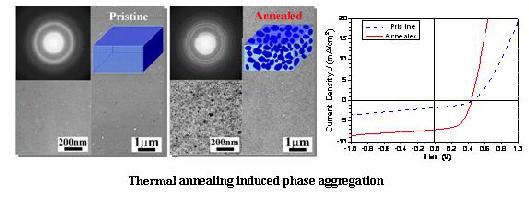As a new type of photovoltaic conversion device, polymer solar cells are attracting more and more attentions due to the advantages of large-area, flexibility, and low-cost roll-to-roll production by using solution-based thin film deposition technology. Since an ultrafast electron transfer from donor to acceptor was found in a composite system composed of conjugated polymer and fullerene (C60), the bulk heterojunction electron donor–acceptor approach has been regarded as the most successful method to make photoinduced excitons split into free charge carriers, which are subsequently collected by the corresponding electrodes and ultimately give photovoltaic electricity.

Yang et al reported a thermal annealing method to induce controllable phase aggregation in nanoscale. The pristine polythiophene/C60 composite film was prepared via spin coating from solution, and so the film is far away from thermodynamically equilibrium state. During thermal annealing, fullerene molecules get enough mobility to diffuse within polymer matrix, undergoing a nucleation and crystal growth process. Upon further optimization thus formed fullerene crystals with size ~20nm can be well dispersed within polythiophene matrix. Additionally, although polythiophene is less crystallized in the pristine film due to very fast solvent evaporation, its crystallinity could be improved during thi thermal annealing, which is important for hole transportation in high performance solar cells.
In bulk heterojunction polymer solar cells, both crystallization of the components involved and nanoscale phase separation with bi-continuous pathway are necessary for achieving high performance devices. Upon precisely optimized morphology of the photoactive layer, the performance(power conversion efficiency) of poly(3-hexylthiophene)(P3HT)/C60 solar cells has been dramatically improved from 0.32% to1.73%. In particular, the substantially increased short-circuit current of the solar cells should be mainly resulted from this improved morphology, controlled phase aggregation in nanoscale for the photoactive layer. (Yang et al., Small 2007, 3, 611 – 615)
|
